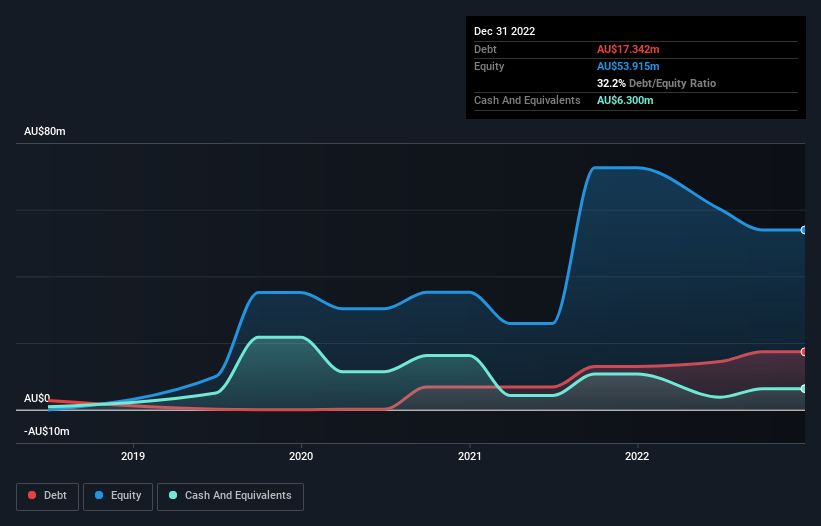Some say volatility, rather than debt, is the best way to think about risk as an investor, but Warren Buffett famously said that 'Volatility is far from synonymous with risk.' When we think about how risky a company is, we always like to look at its use of debt, since debt overload can lead to ruin. As with many other companies Mighty Craft Limited (ASX:MCL) makes use of debt. But is this debt a concern to shareholders?
When Is Debt Dangerous?
Generally speaking, debt only becomes a real problem when a company can't easily pay it off, either by raising capital or with its own cash flow. Ultimately, if the company can't fulfill its legal obligations to repay debt, shareholders could walk away with nothing. However, a more usual (but still expensive) situation is where a company must dilute shareholders at a cheap share price simply to get debt under control. By replacing dilution, though, debt can be an extremely good tool for businesses that need capital to invest in growth at high rates of return. The first step when considering a company's debt levels is to consider its cash and debt together.
See our latest analysis for Mighty Craft
What Is Mighty Craft's Debt?
The image below, which you can click on for greater detail, shows that at December 2022 Mighty Craft had debt of AU$17.3m, up from AU$13.0m in one year. On the flip side, it has AU$6.30m in cash leading to net debt of about AU$11.0m.

A Look At Mighty Craft's Liabilities
According to the last reported balance sheet, Mighty Craft had liabilities of AU$27.2m due within 12 months, and liabilities of AU$35.1m due beyond 12 months. Offsetting these obligations, it had cash of AU$6.30m as well as receivables valued at AU$4.99m due within 12 months. So its liabilities outweigh the sum of its cash and (near-term) receivables by AU$51.0m.
This is a mountain of leverage relative to its market capitalization of AU$55.7m. Should its lenders demand that it shore up the balance sheet, shareholders would likely face severe dilution. When analysing debt levels, the balance sheet is the obvious place to start. But it is future earnings, more than anything, that will determine Mighty Craft's ability to maintain a healthy balance sheet going forward. So if you're focused on the future you can check out this free report showing analyst profit forecasts.
Over 12 months, Mighty Craft reported revenue of AU$84m, which is a gain of 154%, although it did not report any earnings before interest and tax. So there's no doubt that shareholders are cheering for growth
Caveat Emptor
Despite the top line growth, Mighty Craft still had an earnings before interest and tax (EBIT) loss over the last year. Its EBIT loss was a whopping AU$12m. Considering that alongside the liabilities mentioned above does not give us much confidence that company should be using so much debt. Quite frankly we think the balance sheet is far from match-fit, although it could be improved with time. Another cause for caution is that is bled AU$8.5m in negative free cash flow over the last twelve months. So in short it's a really risky stock. When analysing debt levels, the balance sheet is the obvious place to start. However, not all investment risk resides within the balance sheet - far from it. We've identified 4 warning signs with Mighty Craft , and understanding them should be part of your investment process.
At the end of the day, it's often better to focus on companies that are free from net debt. You can access our special list of such companies (all with a track record of profit growth). It's free.
New: Manage All Your Stock Portfolios in One Place
We've created the ultimate portfolio companion for stock investors, and it's free.
• Connect an unlimited number of Portfolios and see your total in one currency
• Be alerted to new Warning Signs or Risks via email or mobile
• Track the Fair Value of your stocks
Have feedback on this article? Concerned about the content? Get in touch with us directly. Alternatively, email editorial-team (at) simplywallst.com.
This article by Simply Wall St is general in nature. We provide commentary based on historical data and analyst forecasts only using an unbiased methodology and our articles are not intended to be financial advice. It does not constitute a recommendation to buy or sell any stock, and does not take account of your objectives, or your financial situation. We aim to bring you long-term focused analysis driven by fundamental data. Note that our analysis may not factor in the latest price-sensitive company announcements or qualitative material. Simply Wall St has no position in any stocks mentioned.
About ASX:MCL
Mighty Craft
Engages in the acquisition and operation of various breweries, distilleries, bars, and restaurants in Australia.
Slight and slightly overvalued.
Similar Companies
Market Insights
Community Narratives



